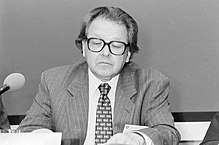George Radda
Sir George Charles Radda CBE FRS (Hungarian: György Károly Radda; born 9 June 1936)[6] is a Hungarian chemist. In 1957 he attended Merton College, Oxford, to study chemistry, having set aside an earlier interest in literary criticism.[2][7] His early work was concerned with the development and use of fluorescent probes for the study of structure and function of membranes and enzymes. He became interested in using spectroscopic methods including nuclear magnetic resonance (NMR) to study complex biological material.[7] In 1974, his research paper was the first to introduce the use of NMR to study tissue metabolites. In 1981, he and his colleagues published the first scientific report on the clinical application of his work. This resulted in the installation of a magnet large enough to accommodate the whole human body for NMR investigations in 1983 at the John Radcliffe Hospital in Oxford.[7][8]
Sir George Radda | |
|---|---|
 Radda in July 1996 | |
| Born | 9 June 1936 |
| Alma mater | University of Oxford |
| Known for | Molecular imaging of heart metabolism and function |
| Awards |
|
| Scientific career | |
| Institutions | |
| Doctoral students | Alister McGrath |
| Website | imaging |
From 1996, until his retirement in 2004, Sir George was Chief Executive of the Medical Research Council in the UK. Currently, Sir George is the new head of the merged departments of Physiology and Human Anatomy and Genetics at the University of Oxford and Chairman of the Singapore Bioimaging Consortium, a research institute of ASTAR in Singapore.
Awards
He has received numerous prestigious awards and honours for his pioneering efforts in using spectroscopic techniques for metabolic studies, including a Buchanan Medal in 1987,[3] an CBE in June 1993 and a knighthood in June 2000. He is a Fellow of Merton College, Oxford,[9] a Fellow of the Royal Society[10] and is a British Heart Foundation Professor of Molecular Cardiology.[11] He has also been awarded many distinguished prizes throughout his scientific career. He is an Honorary Member of the American Heart Association[7] and was awarded the Citation for International Achievement.[7]
In 2015, he was conferred Honorary Citizen of Singapore.[12]
References
- Radda, G. K. (1971). "Enzyme and membrane conformation in biochemical control". The Biochemical Journal. 122 (4): 385–96. doi:10.1042/bj1220385. PMC 1176792. PMID 4942951.
- Lewin, Roger (10 June 1971). "Choosing The Right Problem". New Scientist and Science Journal. 50 (755): 642–643. ISSN 0262-4079.
- "Buchanan Medal". The Royal Society. Retrieved 10 June 2013.
- "Sir George Radda". Oxford Biomedical Imaging Network. Archived from the original on 20 June 2013. Retrieved 10 June 2013.
- "Professor Sir George Radda". Agency for Science, Technology and Research. 6 October 2011. Retrieved 10 June 2013.
- "Birthday's today". The Telegraph. 9 June 2011. Retrieved 2 June 2014.
Prof Sir George Radda, Chief Executive, Medical Research Council, 1996–2003, 75
- "Heartacademy – Newsletter" (PDF). heartacademy.org. p. 3. Retrieved 27 January 2010.
- Radda, G (2011). "Straight talk with...George Radda. Interview by David Cyranoski". Nature Medicine. 17 (5): 525. doi:10.1038/nm0511-525. PMID 21546958.
- "Emeritus, Visiting and Honorary Fellows at Merton College, Oxford". Merton College, Oxford. Archived from the original on 18 June 2013. Retrieved 10 June 2013.
- "Fellows of the Royal Society" (PDF). The Royal Society. 13 April 2013. Retrieved 10 June 2013.
- "House of Lords – Animals in Scientific Procedures – Minutes of Evidence". UK Parliament. Retrieved 10 June 2013.
- Khew, Carolyn (22 October 2015). "Two foreigners made Honorary Citizens of S'pore". The Straits Times. Retrieved 22 February 2020.